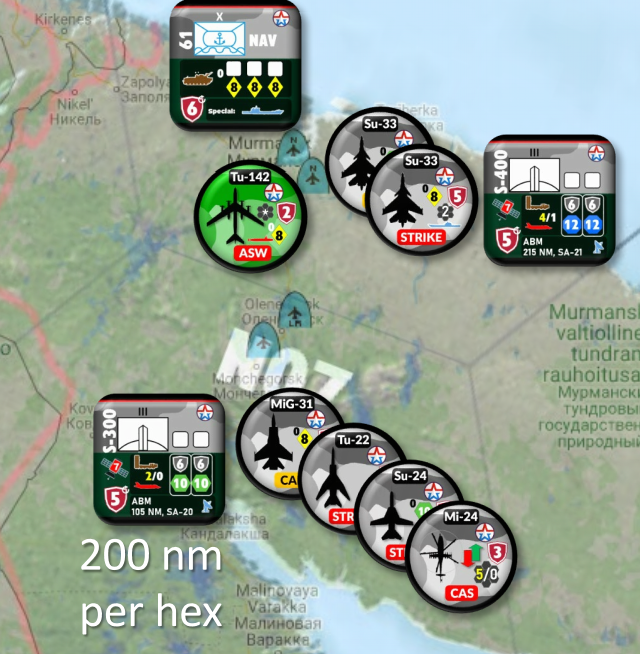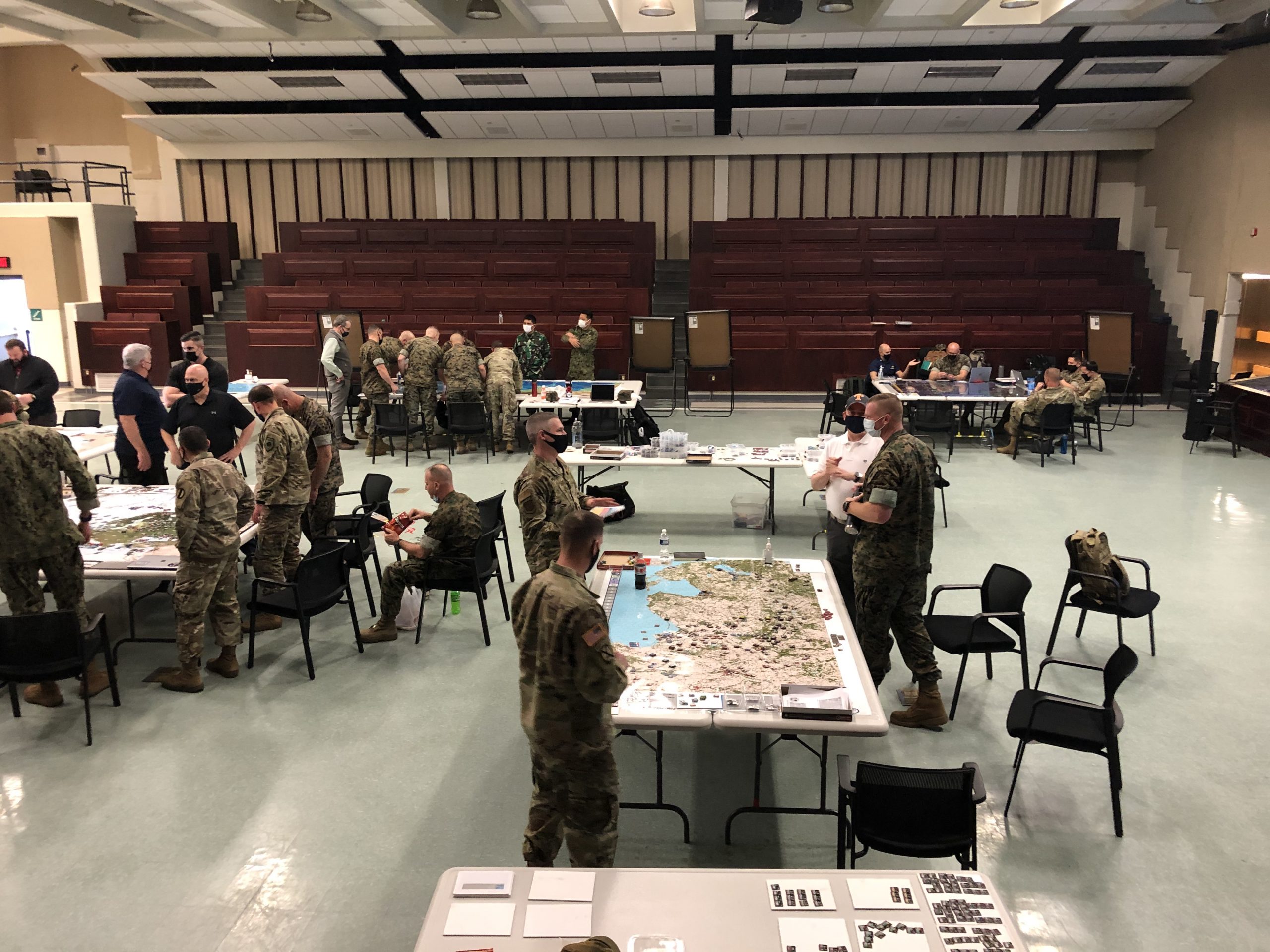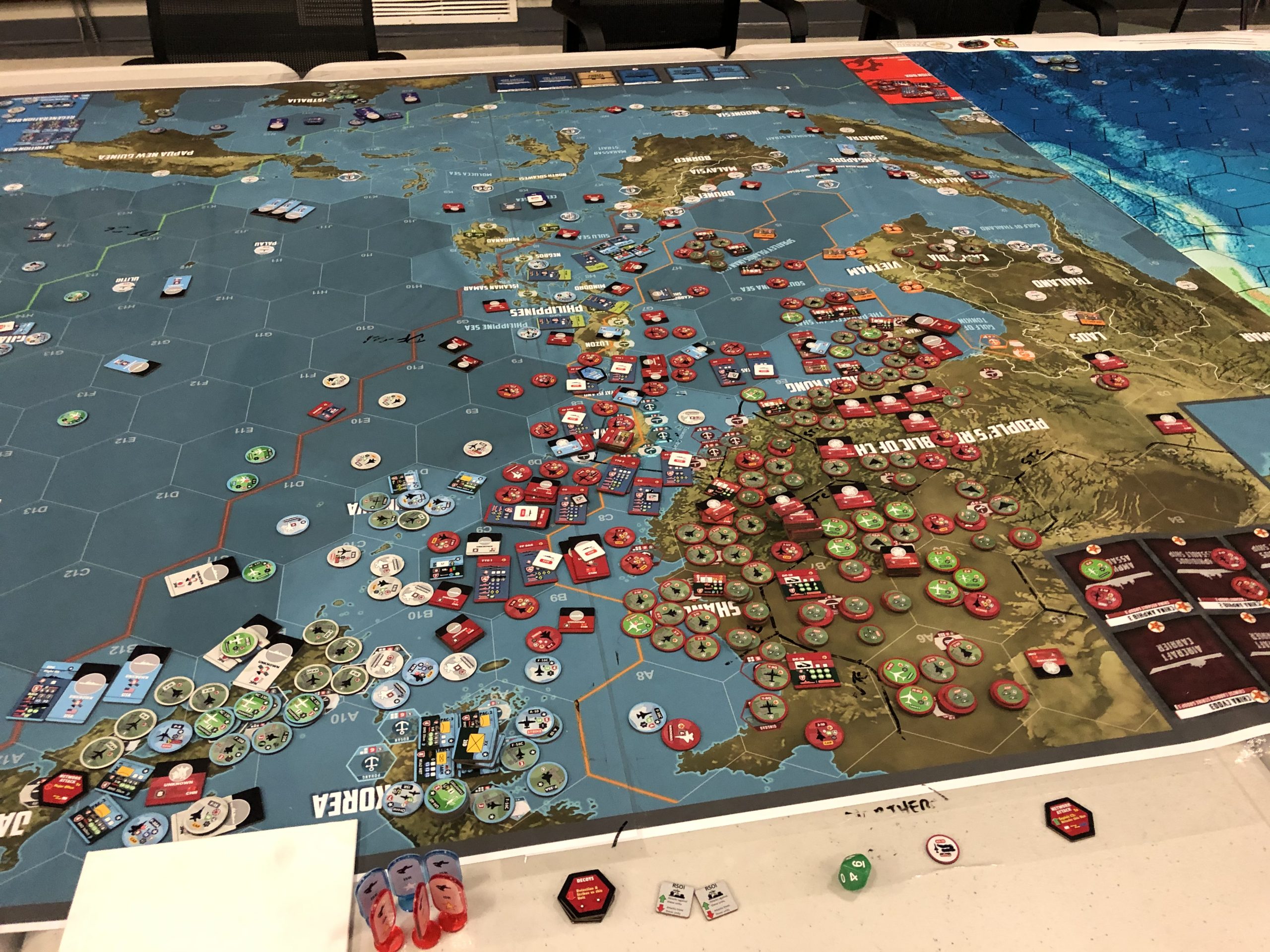The Operational Wargame Series: The best game not in stores now
By Mitch Reed
I try not to mix my work on NDNG with my day job since despite them both having “wargame” in the title they are vastly different and done for very different reasons. Last summer I was asked by the USMC Warfighting Lab to help them playtest a game called Assassin’s Mace which is based on the Operational Wargame Series rules and is developed by the USMCWL. I was immediately impressed with the game system and felt that the hobby community would enjoy hearing about it. What Is the Operational Wargame Series?
The Operational Wargame Series (OWS) is a tabletop game that allows the players to simulate combat between 2025 and 2050. The game is focused on the operational level of warfare and ties in the effects of military capabilities across all domains. The game developed by the recently Retired Col Tim Barrick and a team of designers at the USMCWL really gets to the flavor of the difficulties and myriad of decisions a commander of an operational campaign has to make.
To me the beauty of the game is that Col Barrick, who is an avid hobby gamer, took some of the best mechanics from the hobby world and created a game that service members can play as a part of military education, concept development and joint campaign planning.

As of now, the game as two modules, the first is Assassin’s Mace which focuses on the INDO-PACOM theater and Zapad, the newer of the modules which covers the European theater. Hobby gamers will notice how OWS is a true “hex and counter” game that many in the hobby community would be familiar with.
OWS Mechanics
The game map which represents the overall theater is scaled to 200nm and the tactical map is scaled to 10nm per hex which enables a team to play a large fight and a smaller on that focuses on a small part of the theater such as the island of Taiwan as seen in Assassin’s Mace.

The counters, which are huge, can be used on either map and represent units such as naval ships, flying squadrons, SAM batteries and maneuver battalions/companies for the ground fight. The counters are more than just a marker that represents where a unit is on the map. The counters also function as a true unit info card which you can see it’s offensive and defensive capabilities and mark off unit status as it takes losses.

The real core mechanic is how dice are used in the game. The dice act as an instant adjudicator and the system uses different sizes of dice that can be adjusted during game play. A high percentage attack would roll a d20, however if the unit is degraded it may roll a d16 or d12 depending on the status of the unit and the environment it is in.
The rolls also work the other direction where a player can have a unit support a low probability attack which uses a d4 and allow it to use a bigger die, such as a d6 or d8. The game calls these shifts in a roll as being “promoted” or “demoted”, however it also shows the player how by blending or sequencing certain capabilities can increase your probability of success.

OWS Gameplay
The game requires the players to plan out their turn which is usually done by an informal huddle, however is a very important part of the game. Once this is done the players of both sides move all of their units simultaneously and then move into the I/O-Cyber and the ISR portion of the turn which is where you see a lot of the “promotion” and “demotion” occur. After these steps, the combat is adjudicated with air going first, followed by naval and ground combat.

The 24-hour turn then ends with the regeneration phase where air units return to their bases, destroyed units can be possibly brought back in the game and things like logistics are adjusted. The turns do not take very long at all and teams of players can get in 2-3 turns in a normal work day.
Military Application
I was invited to the mega test of the OWS system in early April where the students of USMC War College played the game on five maps which represented the Indo-Pacific, European and the North American theaters with tactical maps for Taiwan and the Baltics. The class of about 30 students were split into two teams, with blue being the US and its allies and the Red being China and Russia.

The students, which were at the O-5 and O-6 level from all the services and some allied/partner nations played the game for three full days and not only had a great time they also learned a lot.

During professional military education you learn a lot about joint concepts and the theory behind joint warfare. Unless you have been exposed to this in a previous military job some the students may not be able to “visualize” what the lessons are covering. What OWS does is take what is taught in those lessons and puts it all together in a way where the students put all the moving parts together and then enables them to grasp the all of the classroom concepts.

Another thing OWS does magnificently is to show the players how to blend different capabilities together to achieve their desired effects. When I play tested Zapad in March, we were able to work with the US Army wargamers to jointly roll back the enemy air defenses so we can get them close air support.
Another reason why OWS is a great system is that the rules are easy to learn but tough to master, more on this later.
Hobby Application
Sadly, the game is only available from the US Marine Corps Association and is only available for offices in the DoD who conduct wargaming, so unless this changes you will probably not get your hands on a copy. Which then leads to the next question, could this be a viable game for the hobby market? I feel it could be a big hit if the game goes commercial, which as of now there are no plans for.

The other question I bet you are thinking of is how would a hobby gamer do when playing the games in OWS system. For that I have to say “it depends”. In order to really understand the game, you need a real understanding of how joint warfare works and how different capabilities are used during a campaign. Even a military vet may not have the right amount of knowledge to play the game ‘well” and it would depend on their exposure of operational campaign planning or execution. Even with this said, I think OWS would be a good way to teach hobby gamers on how the joint force fights.

Final Thoughts
I think the team at USMCWL really has developed a sound game that may change how we wargame across the DoD. I am looking at ways in which I can use this game system for my “day job”. I also would love to see this game available for the commercial side of wargaming, I think grogs would just love to play this game.

Where I can find informations and documents related to this system?
Sadly you can not at this point since it is not a commercial game
If it ever becomes one, guess I have another reason to raid my savings!
Sir,
I’m a retired USAF O-5 and am currently a contractor working for a company providing training for the DoD and coalition partners. I can see definite applications for our courses. Could you please connect me with a POC?
Thank you,
Jeff
Jeff… I am USAF retired as well and run wargames for the HAF as a govie. Ill shoot you an email to your yahoo
Good evening,
Long time reader, first time caller. I also have a professional interest in this…do you mind shooting me an email as well? Not a TST on my end, just a good idea fairy.
Thanks.
Excellent Post. I think serious wargamers would eat this up. I’ll take one of each. IT looks like a handful but richly detailed and has excellent production quality! win/win. Sign me up!
Hey Mitch, very curious how this stacks up to something like GMT’s “Next War” series – does this do a little bit more of the truly operational rather than the tactical? Would love to track down a copy of this for the office, but in the meantime once we’re back in person I’m going to insist everyone play at least one of the Next War games.
Mitchell Land has played OWS and knows the guys at USMCWL really well. In the Connections lecture the designer gave today (https://www.youtube.com/watch?v=kz0ab_51wAc) he mentions the NW series and its influence. I recommend the NW series, having played both systems they cover similar ground. As for a work copy, send me an email via this site and I can forward that request for you.
That looks pretty darned good. It looks a lot better than the sims I was involved with. Maybe someone could take the role of the PRC and “reverse engineer” it.
Mitchell, this is the game I have wanted to buy and play for years. If it ever goes commercial, keep us all posted.
I will!